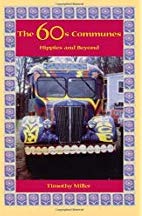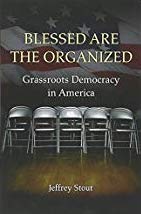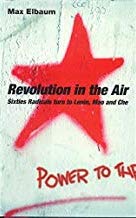Peoples Temple has been studied from numerous perspectives over the years – political, religious, sociological – but it especially deserves further analysis within the context of the post-WWII American Left, once a synthetic study of those sections of our culture is written.
The productivity of such analysis is suggested by numerous aspects of Peoples Temple itself: symbolic and ideological links such as Jim Jones’ admiration of Stalin, Jonestown as an member-described experiment in socialism, and the books of the Jonestown library; practices such as church participation in local elections and Jones’ service on the San Francisco Housing Authority; and the support of activists such as Angela Davis.
 Some scholars have already been making informed, broad-based connections between Peoples Temple and culturally available forms of Marxism and larger trends such as liberation theology. Unfortunately, the needed backdrop of a synthetic study of the post-WWII American Left does not yet exist, although Timothy Miller’s scholarship on mid-20th century communal movements provides a template. After a first volume surveying historical precedents, his second volume The 60s Communes: Hippies and Beyond uses a thoughtful definition to carve out his subject, then presents a mixture of typologies and interesting trends amidst which surface grounded, fascinating observations about more particular cases – for example, that after the Jesus People movement arose due to evangelicalism’s absorption of countercultural style, urban communes predominated there, likely due to member’s concern for evangelization.
Some scholars have already been making informed, broad-based connections between Peoples Temple and culturally available forms of Marxism and larger trends such as liberation theology. Unfortunately, the needed backdrop of a synthetic study of the post-WWII American Left does not yet exist, although Timothy Miller’s scholarship on mid-20th century communal movements provides a template. After a first volume surveying historical precedents, his second volume The 60s Communes: Hippies and Beyond uses a thoughtful definition to carve out his subject, then presents a mixture of typologies and interesting trends amidst which surface grounded, fascinating observations about more particular cases – for example, that after the Jesus People movement arose due to evangelicalism’s absorption of countercultural style, urban communes predominated there, likely due to member’s concern for evangelization.
Although any such study would ideally draw on scattered disciplinary pockets from the full range of social sciences, Miller’s approach seems productively applicable to a synthetic study of the post-WWII American Left, even when viewed only from concepts current within the study of New Religious Movements.
Definition-wise, it seems that the synthetic study would have to use something like Colin Campbell’s sociological framework of the milieu of oppositional subcultures (more widely but less precisely known as the “cultic milieu”): that is, a multiform, linked social underbelly in which relatively unacceptable ideas flourish amidst varied “seeker”-like actors who consider them as they cultivate habits and spaces of tolerance.
Furthermore, this framework seems most usefully employed with rough litmus tests of distance from the mainstream and degree of enduring involvement with politics.
Under such a definition, prominent institutions like the Democratic Party and the Sierra Club seem too mainstream to map, whereas their edgier counterparts like the Democratic Socialists of America and Greenpeace seem worthier of inclusion and analysis.
Since the milieu of oppositional subcultures includes everything from herbal medicine to polyamory, it seems that the most helpful way to further sort through these groups would be some workable measure of the extent to which groups self-conceive and enduringly act as opposition or minority pressure groups within local, state, and national politics. Initially disqualified would be one-off campaigns for candidates or narrowly-defined issue movements, which fold up as soon as an election passes or the issue achieves resolution. Likewise, a local church may be long-lived and turn out its members to vote during big elections, but its activities would likely fail to be consistently political or perhaps even contrarian enough. In contrast to both of these, an organization of ministers who seek to upend and transform local politics through facilitation of voter registration and turnout seems as though it should qualify.
 To take an initial typological stab via riffs off of observations from Jeffrey Stout’s 2010 study Blessed Are the Organized: Grassroots Democracy in America, one possible typology might separate groups out into ideal types of issue-based versus sustained activism, with particular versus programmatic manifestations of the latter. Although many issue-based groups would disqualify due to their respectability or their nature as narrow, limited-duration movements, others – like the anti-nuclear civil disobedience group Plowshares – choose issues and tactics so far outside the mainstream and thus the possibility of any near-term resolution, that they present organizational longevity that is both striking and ripe for analysis. In opposition to issue-based groups would be particular groups constituted around some aspect of identity that continues, even as issues transform over time. Here, a community-organizing group or an immigrant advocacy group would maintain continuity among neighbors or new immigrants, respectively, even as different issues like schooling or affordable housing cycle through the group over time. In contrast yet again would be organizations such as the Green Party or various communist or socialist groups, which are theoretically more open to a broader range of persons and tend to organizationally incorporate or subsume any particular identities, even if their broad-based support might be more aspirational than factual.
To take an initial typological stab via riffs off of observations from Jeffrey Stout’s 2010 study Blessed Are the Organized: Grassroots Democracy in America, one possible typology might separate groups out into ideal types of issue-based versus sustained activism, with particular versus programmatic manifestations of the latter. Although many issue-based groups would disqualify due to their respectability or their nature as narrow, limited-duration movements, others – like the anti-nuclear civil disobedience group Plowshares – choose issues and tactics so far outside the mainstream and thus the possibility of any near-term resolution, that they present organizational longevity that is both striking and ripe for analysis. In opposition to issue-based groups would be particular groups constituted around some aspect of identity that continues, even as issues transform over time. Here, a community-organizing group or an immigrant advocacy group would maintain continuity among neighbors or new immigrants, respectively, even as different issues like schooling or affordable housing cycle through the group over time. In contrast yet again would be organizations such as the Green Party or various communist or socialist groups, which are theoretically more open to a broader range of persons and tend to organizationally incorporate or subsume any particular identities, even if their broad-based support might be more aspirational than factual.
Within such a preliminary definition and typology, any actual trends would depend on assemblage of raw material about actual groups. That includes not only existing academic studies, but also studies by non-academic insiders, as well as primary sources ranging from printed literature to interviews with members.
 Here, one very useful book that tantalizes with its contextualizing content and that will undoubtedly inform any future synthetic work is Max Elbaum’s 2002 survey Revolution in the Air: Sixties Radicals Turn to Lenin, Mao and Che. To briefly summarize some key points, the perceptive former insider Elbaum takes as his historical topic the post-1968 Communist organizations that advocated overthrowing the U.S. government prior to their overall folding and fading during the rightwing turn of the Reagan years. After McCarthyism and Soviet criticism of Stalin destabilized the “Old Left” which had been dominated by the American Communist Party, these groups independently gestated out of reading and study groups among young radicals, who after a period of open-minded reading and experimentation settled into what might be called “vanguard voluntarism.” Namely, ideologically conformist cadres nurtured the spark of revolution and prepared its further fanning through recruitment, campaigns, and literature production, although they typically did not actually arm themselves.
Here, one very useful book that tantalizes with its contextualizing content and that will undoubtedly inform any future synthetic work is Max Elbaum’s 2002 survey Revolution in the Air: Sixties Radicals Turn to Lenin, Mao and Che. To briefly summarize some key points, the perceptive former insider Elbaum takes as his historical topic the post-1968 Communist organizations that advocated overthrowing the U.S. government prior to their overall folding and fading during the rightwing turn of the Reagan years. After McCarthyism and Soviet criticism of Stalin destabilized the “Old Left” which had been dominated by the American Communist Party, these groups independently gestated out of reading and study groups among young radicals, who after a period of open-minded reading and experimentation settled into what might be called “vanguard voluntarism.” Namely, ideologically conformist cadres nurtured the spark of revolution and prepared its further fanning through recruitment, campaigns, and literature production, although they typically did not actually arm themselves.
Within the synthetic study’s mused scope and the concrete point of comparison provided by Elbaum, then, presenting themselves are a number of parameters that also help us to think about Peoples Temple.
-
- Nature and Depth of Affiliation: Does an organization function more like a mainstream political party and occasionally claim one portion of a member’s life, or does it subsume identity and demand greater commitment, perhaps even to the point where it displaces cultural content termed “religion”? Do different levels of affiliation exist, and if so, what levels of commitment do they entail?
For example, the cadres described by Elbaum could demand high levels of participation more typically associated with New Religious Movements, with pure Communist ideology occupying the space of religion. In comparison, persons under recruitment at infiltrated organizations like workplaces might not even be initially aware of the evangelistic designs of a cadre member, since they often would not openly profess their affiliation.
-
- Leadership and Governance: Does an organization operate by charismatic, traditional, or bureaucratic authority? Within bureaucratic authority, are groups oligarchic or democratic? What relationships exist among different tiers of members?
For example, the cadres described by Elbaum tended to be formally bureaucratic and maintained voting procedures among executive committees, with group pressures often forcing unanimity.
-
- Ideology: What is good, and why? What duties stem from this?
For example, despite the wide variety of reading in their early years, the cadres described by Elbaum eventually converged on the Maoist Cultural Revolution-era idea that ideological purity was paramount for a successful long-term takeover.
-
- Practices: What actions do groups typically take, both within their organizations and in relating to the larger body politic?
For example, the cadres described by Elbaum engaged in sessions of mutual criticism to ensure ideological conformity, and largely intervened externally through the methods of literature, protest, and organizing. Interestingly, the talk of armed revolution was generally not actually met through the maintenance of arms.
-
- Stigmatization: Since the groups are oppositional to some degree, to what extent are they villainized by others, or do their names even become bywords of villainization?
For example, after leaving the cadres described by Elbaum, members could face difficulty in finding employment, due to the extremity of their viewpoints as perceived by those in the labor and non-profit world.
To extrapolate from just this one contextualizing work that would inform the much fuller synthetic study, several lines of analysis present themselves for thinking about Peoples Temple in the context of the post-WWII American Left.
First, as both former Temple members and scholars know, Peoples Temple should be thought of in phases, particularly stateside church versus Jonestown.
Second, as a stateside church, much of the Peoples Temple organization-external activity during its San Francisco era seem just a slightly stronger manifestation of a run-of-the-mill politically engaged church. Whether turning out the vote amidst exaggerations of influence, or seeking respectability and providing a base from which Jones secured a city appointment, church members don’t seem an exceptionally political entity – a conclusion incidentally but importantly reached by the IRS following its investigation of the Temple in Spring 1978.
Third, within the stateside church, the Planning Commission seems the most recognizable locus of similarities due to some practices like group criticism of individuals, although this is counterbalanced by church business such as counseling within the broader church membership, as Laura Johnston Kohl points out in her 2010 memoir, Jonestown Survivor: An Insider’s Look.
Fourth, within the stateside church, the accumulation of guns and heightening of security seems strikingly disconnected from any explicit political project, and more an outgrowth of local tensions and burgeoning celebrity.
Fifth, Jonestown itself opens into broader questions of communitarian projects as political projects, a separate pocket in the milieu of oppositional subcultures.
These are only preliminary thoughts, on what would be much more informed comparisons, given a full study of the post-WWII American Left. Such a study would be an act of service for scholarship as a whole as well as broader publics, apart from its narrow application to the interesting but admittedly atypical entity that was Peoples Temple.
(David Mihalyfy received his Ph.D. in the History of Christianity in 2017 from the University of Chicago Divinity School. His academic interests include New Religious Movements, the history of religion in America, and the history of Christian biblical interpretation. He has taught social science classes at the School of the Art Institute of Chicago, and freshman writing at the University of Chicago. His writing on higher education reform and his workplace unionization activism has led him to seek public office as an alderman in Chicago in the 2019 election. His full collection of articles for the jonestown report may be found here. He may be reached here.)